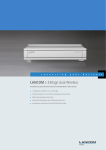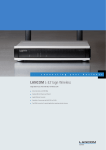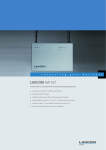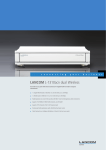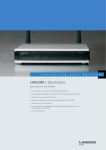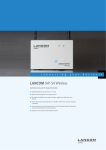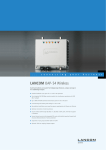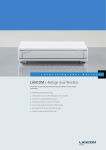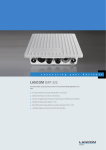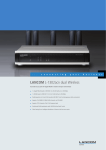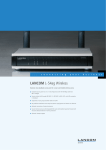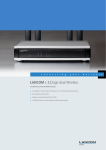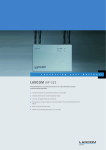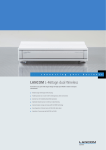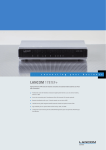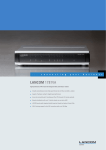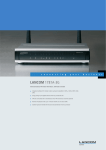Download Lancom Systems L-151E Wireless
Transcript
LANCOM L-151E Wireless Innovative access point for WLAN, the update of Wireless ePaper Displays, and iBeacon technology 1 WLAN based on IEEE 802.11n for the parallel operation at 2.4 GHz with up to 150 Mbps 1 Integrated radio module for updating LANCOM Wireless ePaper Displays 1 Integrated iBeacon technology 1 Fast Ethernet connector with Power over Ethernet based on IEEE 802.3af The LANCOM L-151E Wireless provides a world’s first innovation: Professional WLAN coverage, wireless updates of LANCOM Wireless ePaper Displays, and iBeacon support in just on access point. The integration of all these radio technologies in one device enables an unprecedented range of applications in just one infrastructure. Digital, wireless labeling. The LANCOM L-151E Wireless is equipped with a radio module for updating the innovative LANCOM Wireless ePaper Displays. Whether it be price modern room labels with automatic updates via the calendar management system, or manual maintenance for instance of menu cards in restaurants – LANCOM Wireless ePaper Displays provide innovative areas of application for all branches of trade and industry! The applied radio technology operates in the 2.4 GHz frequency band and hence ensures a wide range and reliable data transmission. Thanks to the optimal combination of all components, a trouble-free parallel operation of all radio applications is guaranteed. Professional WLAN coverage. With a gross data rate of 150 Mbps the LANCOM L-151E Wireless provides sufficient bandwidth for setting up WLAN infrastructures where bandwidth is not as important as signal coverage and reliability. Combined with the LANCOM Public Spot Option the customer is provided a comfortable Internet guest access, which, in turn, increases the attractiveness of the location. This way, for instance corporate meeting rooms or cafés and restaurants can be equipped with easy guest accesses. More management. LANCOM offers a variety of management options for networks of various sizes and in line with the customer's needs: Ranging from free, practical monitoring and configuration tools for very small networks to intelligent controller solutions that offer the cross-site monitoring and management of wireless networks. The LANCOM access point E series offers the familiar LANCOM flexibility of management: Each access point can be operated in standalone mode and managed with the free administration tools, or it can be centrally managed by a LANCOM WLAN controller. Irrespective of whether the WLAN network is decentralized or centrally managed, a highly specialized monitoring solution is available with LANCOM LSM. This powerful monitoring and surveillance system for medium-sized and large networks is capable of monitoring up to 1,000 devices to give you secure control over your entire network infrastructure. For more information, visit www.lancom.de/en/lsm. More reliability for the future. LANCOM products are fundamentally designed for a product life spanning several years. They are equipped with hardware dimensioned for the future. Even reaching back to older product generations, updates to the LANCOM Operating System – LCOS – are available several times a year, free of charge and offering major features. LANCOM offers unbeatable protection of your investment! LANCOM L-151E Wireless Features as of: LCOS 9.04 WLAN Frequency band 2.4 GHz 2400-2483.5 MHz (ISM) Data rates IEEE 802.11n 144,4 Mbps according to IEEE 802.11n with MCS15 (Fallback to 6,5 Mbps with MCS0) Data rates IEEE 802.11b/g 54 Mbps to IEEE 802.11g (fallback to 48, 36 , 24, 18, 12, 9, 6 Mbps, Automatic Rate Selection) compatible to IEEE 802.11b (11, 5.5, 2, 1 Mbps, Automatic Rate Selection), IEEE 802.11 b/g compatibility mode or pure g or pure b Range IEEE 802.11b/g * Up to 150 m (up to 30 m in buildings) * Range IEEE 802.11n Up to 250 m @ 6.5 Mbps (up to 20 m @ 144,4 Mbps indoor)* Output power at radio module, 2.4 GHz IEEE 802.11b: +18 dBm @ 1 and 2 Mbps, +18 dBm @ 5,5 and 11 Mbps IEEE 802.11g: +18/19 dBm @ 6 up to 36 Mbps, +18 dBm @ 48 Mbps, +17 dBm @ 54 Mbps IEEE 802.11n: +19 dBm @ 6,5 and 13 Mbps (MCS0/8, 20 MHz), +13 dBm @ 65 and 130 Mbps (MCS7/15, 20 MHz) Max. radiated power (EIRP), 2.4 GHz band IEEE 802.11b/g: Up to 20 dBm / 100 mW EIRP (transmission power control according to TPC) Minimum transmission power Transmission power reduction in software in 1 dB steps to min. 0.5 dBm Receiver sensitivity 2.4 GHz IEEE 802.11b: -98 dBm @ 1 Mbps , -94 dBm @ 11 Mbps ; IEEE 802.11g: -96 dBm @ 6 Mbps , -82 dBm @ 54 Mbps ; IEEE 802.11n: -95 dBm @ 6,5 Mbps (MCS0, 20 MHz) , -78 dBm @ 65 Mbps (MCS 7, 20 MHz) Radio channels 2.4 GHz Up to 13 channels, max. 3 non-overlapping (depending on country-specific restrictions) Roaming Seamless handover between radio cells, IAPP support with optional restriction to an ARF context, IEEE 802.11d support Fast roaming* Based on IEEE 802.11r, allows fast roaming procedures between access points. This is possible by using IEEE 802.1X authentication or pre-shared keys in controller based WLAN installations, which save the access keys temporarily and distribute them to the managed access points. Concurrent WLAN clients Up to 30 clients (recommended), 512 clients (max.) Fast client roaming With background scanning, moving LANCOM 'client mode' access points pre-authenticate to alternative access points which offer a better signal before Roaming fails VLAN VLAN ID definable per interface, WLAN SSID, point-to-point connection and routing context (4094 IDs) IEEE 802.1q Dynamic VLAN assignment Dynamic VLAN assignment for target user groups based on MAC addresses, BSSID or SSID by means of external RADIUS server. Q-in-Q tagging Support of layered IEEE 802.1q VLANs (double tagging) Multi-SSID Simultaneous use of up to 8 independent WLAN networks per WLAN interface IGMP snooping Support for Internet Group Management Protocol (IGMP) in the WLAN bridge for WLAN SSIDs and LAN interfaces for specific switching of multicast packets (devices with integrated WLAN only). Automated detection of multicast groups. Configurable action for multicast packets without registration. Configuration of static multicast group members per VLAN ID. Configuration of query simulation for multicast membership per VLAN ID Protected Management Frames Protection of WLAN Management Frames, based on the standard IEEE 802.11w, against man-in-the-middle attacks by using Message Ingegrity Codes (MIC) Security IEEE 802.11i / WPA2 with passphrase (WPA2-Personal) or IEEE 802.1X (WPA2-Enterprise) and hardware-accelerated AES, closed network, WEP64, WEP128, WEP152, user authentication, IEEE 802.1x /EAP, LEPS, WPA1/TKIP EAP Types EAP-TLS, EAP-TTLS/MSCHAPv2, PEAPv0/EAP-MSCHAPv2, PEAPv1/EAP-GTC, EAP-SIM, EAP-AKA, EAP-AKA Prime, EAP-FAST RADIUS server Integrated RADIUS server for MAC address list management EAP server Integrated EAP server for authentication of IEEE 802.1X clients via EAP-TLS, EAP-TTLS, PEAP, MSCHAP or MSCHAPv2 RADIUS Accounting per SSID A RADIUS server can be set for each individual SSID Quality of Service Prioritization according to Wireless Multimedia Extensions (WME, subset of IEEE 802.11e) U-APSD/WMM Power Save Extension of power saving according to IEEE 802.11e by Unscheduled Automatic Power Save Delivery (equivalent to WMM Power Save). U-APSD supports the automatic switch of clients to a doze mode. Increasmed battery lifetime for telephone calls over VoWLAN (Voice over WLAN) Bandwidth limitation per WLAN client Maximum transmit and receive bandwith and an individual VLAN ID can be assigned to each WLAN client (MAC address) Bandwidth limitation per SSID Maximum transmit and receive bandwith can be assigned to each SSID Broken link detection If the link of a chosen LAN interface breaks down, a WLAN module can be deactivated to let the associated clients search for a new base station Background scanning Detection of rogue AP's and the channel information for all WLAN channels during normal AP operation. The Background Scan Time Interval defines the time slots in which an AP or Router searches for a foreign WLAN network in its vicinity. The time interval can be specified in either milliseconds, seconds, minutes, hours or days Client detection Rogue WLAN client detection based on probe requests IEEE 802.1X supplicant Authentication of an access point in WLAN client mode at another access point via IEEE 802.1X (EAP-TLS, EAP-TTLS and PEAP) LANCOM L-151E Wireless Features as of: LCOS 9.04 WLAN Layer-3 Tunneling Layer-3 Tunneling in conformity with the CAPWAP standard allows the bridging of WLANs per SSID to a separate IP subnet. Layer-2 packets are encapsulated in Layer-3 tunnels and transported to a LANCOM WLAN controller. By doing this the access point is independent of the present infrastructure of the network. Possible applications are roaming without changing the IP address and compounding SSIDs without using VLANs. IEEE 802.11u The WLAN standard IEEE 802.11u (Hotspot 2.0) allows for a seamless transition from the cellular network into WLAN hotspots. Authentication methods using SIM card information, certificates or username and password, enable an automatic, encrypted login to WLAN hotspots - without the need to manually enter login credentials. *) Note The effective distances and transmission rates that can be achieved are depending of the site RF conditions LANCOM Active Radio Control Client Steering* WLAN clients are directed actively to the best available access point to provide the best overall load balancing and the highest possible bandwidth for each client. Client Steering can be based on client number, frequency band, and signal strength. RF Optimization* Automatic selection of optimal WLAN channels. Due to reduced channel overlaps, WLAN clients benefit from an improved data throughput. In controller-based installations, an automatic selection of optimal channels is conducted for all managed access points. Adaptive Noise Immunity By using adaptive noise immunity an access point can cut out sources of interferences in the radio field and focusses on clients with a sufficent signal strength. Therefore, WLAN clients profit by having a higher data throughput available due to less interferences. *) Note Only in installations with WLAN controller IEEE 802.11n Features MIMO MIMO technology is a technique which uses multiple transmitters to deliver multiple data streams via different spatial channels. Depending on the existing RF conditions the throughput is multiplied with MIMO technology. MAC Aggregation and Block Acknowledgement MAC Aggregation increase the IEEE 802.11 MAC efficiency by combining MAC data frames and sending it out with a single header. The receiver acknowledges the combined MAC frame with a Block Acknowledgement. Depending on existing RF conditions, this technique improves throughput by up to 20%. Space Time Block Coding (STBC) Coding method according to IEEE 802.11n. The Space Time Block Coding improves reception by coding the data stream in blocks. Low Density Parity Check (LDPC) Low Density Parity Check (LDPC) is an error correcting method. IEEE 802.11n uses convolution coding (CC) as standard error correcting method, the usage of the more effective Low Density Parity Check (LDPC) is optional. Maximal Ratio Combining (MRC) Maximal Ratio Combining (MRC) enables the receiver (access point), in combination with multiple antennas, to optimally combine MIMO signals to improve the client reception at long-range. Short Guard Interval The guard interval is the time between OFDM symbols in the air. IEEE 802.11n gives the option for a shorter 400 nsec guard interval compared to the legacy 800 nsec guard interval. Under ideal RF conditions this increases the throughput by upto 10% WLAN operating modes WLAN access point Infrastructure mode (autonomous operation or managed by LANCOM WLAN controller) WLAN router Use of the LAN connector for simultaneous DSL over LAN, IP router, NAT/Reverse NAT (IP masquerading) DHCP server, DHCP client, DHCP relay server, DNS server, PPPoE client (incl.Multi-PPPoE), PPTP client and server, NetBIOS proxy, DynDNS client, NTP, port mapping, policy-based routing based on routing tags, tagging based on firewall rules, dynamic routing with RIPv2, VRRP WLAN client Transparent WLAN client mode for wireless Ethernet extensions, e.g. connecting PCs or printers by Ethernet; up to 64 MAC addresses. Automatic selection of a WLAN profile (max. 8) with individual access parameters depending on signal strength or priority Wireless ePaper Displays Support of LANCOM Wireless ePaper Displays The device is equipped with a radio module for the update of LANCOM Wireless ePaper Displays in the 2.4 GHz frequency band. iBeacon Support of iBeacon technology The device is equipped with a BLE radio module and can thus transmit a configurable iBeacon. The UUID as well as the major and minor ID are configurable. On top of that, all three radiated powers are supported (near, immediate, far). Firewall Stateful inspection firewall Incoming/Outgoing Traffic inspection based on connection information. Trigger for firewall rules depending on backup status, e.g. simplified rule sets for low-bandwidth backup lines. Limitation of the number of sessions per remote site (ID) Packet filter Check based on the header information of an IP packet (IP or MAC source/destination addresses; source/destination ports, DiffServ attribute); remote-site dependant, direction dependant, bandwidth dependant Extended port forwarding Network Address Translation (NAT) based on protocol and WAN address, i.e. to make internal webservers accessible from WAN N:N IP address mapping N:N IP address mapping for translation of IP addresses or entire networks Tagging The firewall marks packets with routing tags, e.g. for policy-based routing; Source routing tags for the creation of independent firewall rules for different ARF contexts LANCOM L-151E Wireless Features as of: LCOS 9.04 Firewall Actions Forward, drop, reject, block sender address, close destination port, disconnect Notification Via e-mail, SYSLOG or SNMP trap Quality of Service Traffic shaping Dynamic bandwidth management with IP traffic shaping Bandwidth reservation Dynamic reservation of minimum and maximum bandwidths, totally or connection based, separate settings for send and receive directions. Setting relative bandwidth limits for QoS in percent DiffServ/TOS Priority queuing of packets based on DiffServ/TOS fields Packet-size control Automatic packet-size control by fragmentation or Path Maximum Transmission Unit (PMTU) adjustment Layer 2/Layer 3 tagging Automatic or fixed translation of layer-2 priority information (IEEE 802.11p-marked Ethernet frames) to layer-3 DiffServ attributes in routing mode. Translation from layer 3 to layer 2 with automatic recognition of IEEE 802.11p-support in the destination device Security Intrusion Prevention Monitoring and blocking of login attempts and port scans IP spoofing Source IP address check on all interfaces: only IP addresses belonging to the defined IP networks are allowed Access control lists Filtering of IP or MAC addresses and preset protocols for configuration access Denial of Service protection Protection from fragmentation errors and SYN flooding General Detailed settings for handling reassembly, PING, stealth mode and AUTH port URL blocker Filtering of unwanted URLs based on DNS hitlists and wildcard filters Password protection Password-protected configuration access can be set for each interface Alerts Alerts via e-mail, SNMP traps and SYSLOG Authentication mechanisms EAP-TLS, EAP-TTLS, PEAP, MS-CHAP, MS-CHAPv2 as EAP authentication mechanisms, PAP, CHAP, MS-CHAP and MS-CHAPv2 as PPP authentication mechanisms WLAN protocol filters Limitation of the allowed transfer protocols, source and target addresses on the WLAN interface Adjustable reset button Adjustable reset button for 'ignore', 'boot-only' and 'reset-or-boot' IP redirect Fixed redirection of any packet received over the WLAN interface to a dedicated target address High availability / redundancy VRRP VRRP (Virtual Router Redundancy Protocol) for backup in case of failure of a device or remote station. Enables passive standby groups or reciprocal backup between multiple active devices including load balancing and user definable backup priorities FirmSafe For completely safe software upgrades thanks to two stored firmware versions, incl. test mode for firmware updates Line monitoring Line monitoring with LCP echo monitoring, up to 4 addresses for end-to-end monitoring with ICMP polling Routing functions Router IP and NetBIOS/IP multi-protocol router Advanced Routing and Forwarding Separate processing of 16 contexts due to virtualization of the routers. Mapping to VLANs and complete independent management and configuration of IP networks in the device, i.e. individual settings for DHCP, DNS, Firewalling, QoS, VLAN, Routing etc. Automatic learning of routing tags for ARF contexts from the routing table HTTP HTTP and HTTPS server for configuration by web interface DNS DNS client, DNS server, DNS relay, DNS proxy and dynamic DNS client DHCP DHCP client, DHCP relay and DHCP server with autodetection. Cluster of several LANCOM DHCP servers per context (ARF network) enables caching of all DNS assignments at each router. DHCP forwarding to multiple (redundant) DHCP servers NetBIOS NetBIOS/IP proxy NTP NTP client and SNTP server, automatic adjustment for daylight-saving time Policy-based routing Policy-based routing based on routing tags. Based on firewall rules, certain data types are marked for specific routing, e.g. to particular remote sites or lines Dynamic routing Dynamic routing with RIPv2. Learning and propagating routes; separate settings for LAN and WAN. Extended RIPv2 including HopCount, Output Delay, Poisoned Reverse, Triggered Update for LAN (acc. to RFC 2453) and WAN (acc. to RFC 2091) as well as filter options for propagation of routes. Definition of RIP sources with wildcards LANCOM L-151E Wireless Features as of: LCOS 9.04 Routing functions DHCPv6 DHCPv6 client, DHCPv6 server, DHCPv6 relay, stateless- and stateful mode, IPv6 address (IA_NA), prefix delegation (IA_PD), DHCPv6 reconfigure (server and client) Layer 2 functions ARP lookup Packets sent in response to LCOS service requests (e.g. for Telnet, SSH, SNTP, SMTP, HTTP(S), SNMP, etc.) via Ethernet can be routed directly to the requesting station (default) or to a target determined by ARP lookup LLDP Automatic discovery of network topology in layer 2 networks (Link Layer Discover Protocol) DHCP option 82 DHCP relay agent information (option 82) can be insterted on devices with WLAN bridge (RFC 3046) IPv6 layer 2 protocol filter Router advertisement snopping blocks illegal IPv6 router advertisements in the WLAN bridge. DHCPv6 snopping blocks all illegal DHCPv6 servers. The lightweight DHCPv6 relay agent (LDRA) can insert relay agent information on layer 2. LAN protocols IP ARP, proxy ARP, BOOTP, DHCP, DNS, HTTP, HTTPS, IP, ICMP, NTP/SNTP, NetBIOS, PPPoE (server), RADIUS, RIP-1, RIP-2, RTP, SIP, SNMP, TCP, TFTP, UDP, VRRP, VLAN Rapid Spanning Tree IEEE 802.1d Spanning Tree and IEEE 802.1w Rapid Spanning Tree support for dynamic path selection with redundant layer 2 connections IPv6 NDP, stateless address autoconfiguration (SLAAC), stateful address autoconfiguration (with DHCPv6), router advertisements, ICMPv6, DHCPv6, DNS, HTTP, HTTPS, PPPoE, RADIUS, TCP, UDP, SMTP IPv6 Dual Stack IPv4/IPv6 dual stack IPv6 compatible LCOS applications WEBconfig, HTTP, HTTPS, SSH, Telnet, DNS, TFTP, Firewall, RAS dial-in WAN protocols Ethernet PPPoE, Multi-PPPoE, ML-PPP, PPTP (PAC or PNS), L2TPv2 (LAC or LNS) and IPoE (with or without DHCP), RIP-1, RIP-2, VLAN, IP IPv6 IPv6 over PPP (IPv6 and IPv4/IPv6 dual stack session), IPoE (autoconfiguration, DHCPv6 or static) Tunneling protocols (IPv4/IPv6) 6to4, 6in4, 6rd (static and via DHCP), Dual Stack Lite (IPv4 in IPv6 tunnel) WAN operating mode xDSL (ext. modem) ADSL1, ADSL2 or ADSL2+ with external ADSL2+ modem Interfaces ETH 10/100Base-TX, autosensing, auto node hub, PoE compliant with IEEE 802.3af DSL over LAN (DSLoL) The LAN port can (even parallel to LAN mode) be used as a WAN port for connecting external DSL modems (PPPoE) or external routers. External antenna connectors Two reverse SMA connectors for external antennas can be used to control Wireless ePaper Displays and iBeacon. Please respect the restrictions which apply in your country when setting up an antenna system. LCMS (LANCOM Management System) LANconfig Configuration program for Microsoft Windows, incl. convenient Setup Wizards. Optional group configuration, simultaneous remote configuration and management of multiple devices over IP connection (HTTPS, HTTP, SSH, TFTP). A tree view of the setting pages like in WEBconfig provides quick access to all settings in the configuration window. Password fields which optionally display the password in plain text and can generate complex passwords. Configuration program properties per project or user. Automatic storage of the current configuration before firmware updates. Exchange of configuration files between similar devices, e.g. for migrating existing configurations to new LANCOM products. Detection and display of the LANCOM managed switches. Extensive application help for LANconfig and parameter help for device configuration. LANCOM QuickFinder as search filter within LANconfig and device configurations that reduces the view to devices with matching properties. Central configuration of each management port. LANmonitor Monitoring application for Microsoft Windows for (remote) surveillance and logging of the status of LANCOM devices and connections, incl. PING diagnosis and TRACE with filters and save to file. Search function within TRACE tasks. Wizards for standard diagnostics. Export of diagnostic files for support purposes (including bootlog, sysinfo and device configuration without passwords). Graphic display of key values (marked with an icon in LANmonitor view) over time as well as table for minimum, maximum and average in a separate window, e. g. for Rx, Tx, CPU load, free memory. Monitoring of the LANCOM managed switches. Flick easily through different search results by LANCOM QuickFinder WLANmonitor Monitoring application for Microsoft Windows for the visualization and monitoring of LANCOM WLAN installations, incl. Rogue AP and Rogue Client visualization. LANCOM QuickFinder as search filter that reduces the view to devices with matching properties Firewall GUI Graphical user interface for configuring the object-oriented firewall in LANconfig: Tabular presentation with symbols for rapid understanding of objects, choice of symbols for objects, objects for actions/Quality of Service/remote sites/services, default objects for common scenarios, individual object definition (e.g. for user groups) LANCOM L-151E Wireless Features as of: LCOS 9.04 LCMS (LANCOM Management System) Automatic software update Voluntary automatic updates for LCMS. Search online for LCOS updates for devices managed by LANconfig on the myLANCOM download server (myLANCOM account mandatory). Updates can be applied directly after the download or at a later time Management WEBconfig Integrated web server for the configuration of LANCOM devices via Internet browsers with HTTPS or HTTP. Similar to LANconfig with a system overview, SYSLOG and events display, symbols in the menu tree, quick access with side tabs. WEBconfig also features Wizards for basic configuration, security, Internet access, LAN-LAN coupling. Online help for parameters in LCOS menu tree LANCOM Layer 2 Management (emergency management) The LANCOM Layer 2 Management protocol (LL2M) enables an encrypted access between the command line interfaces of two LANCOM device directly via a Layer 2 connection Alternative boot configuration During rollout devices can be preset with project- or customer-specific settings. Up to two boot- and reset-persistent memory spaces can store customized configurations for customer-specific standard settings (memory space '1') or as a rollout configuration (memory space '2'). A further option is the storage of a persistent standard certificate for the authentication of connections during rollouts Device SYSLOG SYSLOG buffer in the RAM (size depending on device memory) to store events for diagnosis. Default set of rules for the event protocol in SYSLOG. The rules can be modified by the administrator. Display and saving of internal SYSLOG buffer (events) from LANCOM devices with LANmonitor, display only with WEBconfig Access rights Individual access and function rights for up to 16 administrators. Alternative access control on a per parameter basis with TACACS+ User administration RADIUS user administration for dial-in access (PPP/PPTP). Support for RADSEC (Secure RADIUS) providing secure communication with RADIUS servers Remote maintenance Remote configuration with Telnet/SSL, SSH (with password or public key), browser (HTTP/HTTPS), TFTP or SNMP, firmware upload via HTTP/HTTPS or TFTP TACACS+ Support of TACACS+ protocol for authentication, authorization and accounting (AAA) with reliable connections and encrypted payload. Authentication and authorization are separated completely. LANCOM access rights are converted to TACACS+ levels. With TACACS+ access can be granted per parameter, path, command or functionality for LANconfig, WEBconfig or Telnet/SSH. Each access and all changes of configuration are logged. Access verification and logging of SNMP Get and Set requests. WEBconfig supports the access rights of TACACS+ and choice of TACACS+ server at login. LANconfig provides a device login with the TACACS+ request conveyed by the addressed device. Authorization to execute scripts and each command within them by checking the TACACS+ server’s database. CRON, action-table and script processing can be diverted to avoid TACACS+ to relieve TACACS+ servers. Redundancy by setting several alternative TACACS+ servers. Configurable option to fall back to local user accounts in case of connection drops to the TACACS+ servers. Compatibility mode to support several free TACACS+ implementations RADIUS Support of RADIUS protocol for authentication of configuration access. Administrative privileges can be assigned for each administrator. Remote maintenance of 3rd party devices A remote configuration for devices behind der LANCOM can be accomplished (after authentication) via tunneling of arbitrary TCP-based protocols, e.g. for HTTP(S) remote maintenance of VoIP phones or printers of the LAN. Additionally, SSH and Telnet client allow to access other devices from a LANCOM device with an interface to the target subnet if the LANCOM device can be reached at its command line interface TFTP & HTTP(S) client For downloading firmware and configuration files from a TFTP, HTTP or HTTPS server with variable file names (wildcards for name, MAC/IP address, serial number), e.g. for roll-out management. Commands for live Telnet session, scripts or CRON jobs. HTTPS Client authentication possible by username and password or by certificate SSH & Telnet client SSH-client function compatible to Open SSH under Linux and Unix operating systems for accessing third-party components from a LANCOM router. Also usable when working with SSH to login to the LANCOM device. Support for certificate- and password-based authentication. Generates its own key with sshkeygen. SSH client functions are restricted to administrators with appropriate rights. Telnet client function to login/administer third party devices or other LANCOM devices from command line interface HTTPS Server Option to choose if an uploaded certificate or the default certificate is used by the HTTPS server Security Access rights (read/write) over WAN or (W)LAN can be set up separately (Telnet/SSL, SSH, SNMP, HTTPS/HTTP), access control list Scripting Scripting function for batch-programming of all command-line parameters and for transferring (partial) configurations, irrespective of software versions and device types, incl. test mode for parameter changes. Utilization of timed control (CRON) or connection establishment and termination to run scripts for automation. Scripts can send e-mails with various command line outputs as attachments Load commands LoadFirmware, LoadConfig and LoadScript can be executed conditionally in case certain requirements are met. For example, the command LoadFirmware could be executed on a daily basis and check each time if the current firmware is up to date or if a new version is available. In addition, LoadFile allows the upload of files including certificates and secured PKCS#12 containers SNMP SNMP management via SNMPv2, new unified private MIB for all most current and future LANCOM devices with LCOS. Download link in WEBconfig Timed control Scheduled control of parameters and actions with CRON service Diagnosis Extensive LOG and TRACE options, PING and TRACEROUTE for checking connections, LANmonitor status display, internal logging buffer for SYSLOG and firewall events LANCOM WLAN controller Supported by all LANCOM WLAN controller (separate optional hardware equipment for installation, optimization, operating and monitoring of WLAN networks, except for P2P connections) LANCOM L-151E Wireless Features as of: LCOS 9.04 Statistics Statistics Extensive Ethernet, IP and DNS statistics; SYSLOG error counter Accounting Connection time, online time, transfer volumes per station. Snapshot function for regular read-out of values at the end of a billing period. Timed (CRON) command to reset all counters at once Export Accounting information exportable via LANmonitor and SYSLOG Hardware Power supply 12 V DC, external power adapter (230 V) with bayonet cap to protect against accidentally unplugging Power supply Via Power over Ethernet, compliant with IEEE 802.3af Environment Temperature range 0–50° C; humidity 0–95%; non-condensing Housing Robust synthetic housing, rear connectors, ready for wall mounting, Kensington lock; 210 x 45 x 140 mm (W x H x D) Power consumption (max) approx. 5 Watts with 12 V/ 1,5 A power supply adapter (total power consumption of access point and power supply adapter), approx. 4.3 Watts via PoE Declarations of conformity* CE EN 60950-1, EN 301 489-1, EN 301 489-17 2.4 GHz WLAN EN 300 328 IPv6 IPv6 Ready Gold *) Note You will find all declarations of conformity in the products section of our website at www.lancom-systems.de/en Scope of delivery Manual Installation Guide (DE/EN/FR/ES/IT/PT/NL) CD/DVD Data medium with management software (LANconfig, LANmonitor, WLANmonitor, LANCAPI) and documentation Cable 1 Ethernet cable, 3 m Antennas Two 3 dBi dipole antennas Power supply unit External power adapter (230 V), NEST 12 V/1.5 A DC/S, coaxial power connector 2.1/5.5 mm bayonet, temperature range from -5 to +45° C, LANCOM item no. 110723 (EU)/LANCOM item no 110829 (UK) (not included in bulk delivery) Support Warranty 3 years support via hotline and Internet KnowledgeBase Software updates Regular free updates (LCOS operating system and LANCOM Management System) via Internet Options Advance Replacement LANCOM Next Business Day Service Extension CPE, item no. 61411 Warranty Extension LANCOM 2-Year Warranty Extension CPE, item no. 61414 Accessories LANCOM WDG-1 2.7" 2.7" LANCOM Wireless ePaper Display, updates via radio with LANCOM access points of the E series, fully graphics-compatible and daylight-readable, battery life of 5-7 years, incl. white and black clip-on frames and table holders, item no. 62213 (bulk 5) LANCOM WDG-1 4.4" 4.4" LANCOM Wireless ePaper Display, updates via radio with LANCOM access points of the E series, fully graphics-compatible and daylight-readable, battery life of 5-7 years, incl. white and black click-on frame, table holders, and wall bracket, item no. 62211 and item no. 62214 (bulk 5) LANCOM WDG-1 7.4" 7.4" LANCOM Wireless ePaper Display, updates via radio with LANCOM access points of the E series, fully graphics-compatible and daylight-readable, battery life of 5-7 years, incl. white and black click-on frame, table holders, and wall bracket, item no. 62212 and item no. 62215 (bulk 5) LANCOM Wireless ePaper Server Central server for the operation of LANCOM Wireless ePaper infrastructures, with interface (API) for connection to ext. calendar management systems (Exchange/Domino/iCalendar) and ERP systems, image upload, item no. 62201 (License S +1/+50), item no. 62202 (License M +5/+500) and item no. 62203 (License L +10/+1000) LANCOM Large Scale Monitor Powerful monitoring system for WLAN, VPN, and LAN infrastructures of mid-sized to large networks, upgradable for up to 1000 monitored devices, for a proactive error management, browser-based remote monitoring, intuitive user interface, graphic floorplans, configurable triggers for alarms and messages, users, roles, and rights management, item no. 62910 LANCOM WLC-4006+ (EU/UK) LANCOM WLAN controller for central management of 6 (opt. up to 30) LANCOM access points and WLAN routers, item no. 62035 (EU) and item no. 62036 (UK) LANCOM WLC-4025+ (EU/UK) LANCOM WLAN controller for central management of 25 (opt. up to 100) LANCOM access points and WLAN routers, item no. 61378 and item no. Art.-Nr. 61379 LANCOM L-151E Wireless Features as of: LCOS 9.04 Accessories LANCOM WLC-4100 (EU/UK) LANCOM WLAN controller for central management of 100 (opt. up to 1000) LANCOM access points and WLAN routers, item no. 61369 (EU) and item no. 61377 (UK) LANCOM Wall Mount For simple, theft-proof mounting of LANCOM devices with plastic housings, item no. 61349 LANCOM Wall Mount (White) For simple, theft-proof mounting of LANCOM devices with plastic housings, item no. 61345 Power over Ethernet Injector LANCOM PoE Power Injector, item no. 61502 (EU) and 61503 (UK) Power over Ethernet Injector LANCOM GE PoE Power Injector, item no. 61554 (EU) and 61555 (UK) *) Note The polarization diversity antennas require 2 cables and surge arrestors LANCOM L-151E Wireless (EU,UK) 61577 (EU), 61581 (UK) LANCOM L-151E Wireless 10-piece bulk 61585 www.lancom.eu LANCOM Systems GmbH I Adenauerstr. 20/B2 I 52146 Wuerselen I Germany I E-Mail [email protected] I Internet www.lancom.eu LANCOM, LANCOM Systems and LCOS are registered trademarks. All other names or descriptions used may be trademarks or registered trademarks of their owners. Subject to change without notice. No liability for technical errors and/or omissions. 9/2014 Item number(s)










